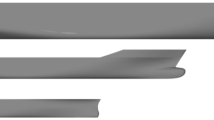Abstract
In this research, a commercial CFD code “Fluent” was applied to optimization of bulbous bow shape for a non ballast water ships (NBS). The ship was developed at the Laboratory of the authors in Osaka Prefecture University, Japan. At first, accuracy of the CFD code was validated by comparing the CFD results with experimental results at towing tank of Osaka Prefecture University. In the optimizing process, the resistances acting on ships in calm water and in regular head waves were defined as the object function. Following features of bulbous bow shapes were considered as design parameters: volume of bulbous bow, height of its volume center, angle of bow bottom, and length of bulbous bow. When referring to the computed results given by the CFD like resistance, pressure and wave pattern made by ships in calm water and in waves, an optimal bow shape for ships was discovered by comparing the results in the series of bow shapes. In the computation on waves, the ship is in fully captured condition because shorter waves, λ/L pp <0.6, are assumed.
Similar content being viewed by others
References
He NV, Nihei Y, Ikeda Y (2012a). A study on application of a commercial CFD code to reduce resistance acting on a NBT-Part 1. The Japan Society of Naval Architects and Ocean Engineers, Kobe, 415–418.
He NV, Nihei Y, Ikeda Y (2012b). A study on application of CFD code to reduce resistance acting on a non ballast tanker-Part 2. The 6 th Asia-Pacific Workshop on Marine Hydrodynamic, Johor, 264–269.
He NV, Nihei Y, Ikeda Y (2012c). A study on an optimum hull form in waves for a non ballast tankers and bulkers. The Advanced Maritime Engineering Conference and the 5 th Pan Asian Association of Maritime Engineering Societies, Taipei, Paper No. NSC-01.
Tatsumi T, Nihei Y, Ikeda Y (2010). Development of a new energy saving tanker with non ballast water and podded propulsor. The 5th Asia-Pacific Workshop on Marine Hydrodynamic, Osaka, 25–28.
Tatsumi T, Nihei Y, Ikeda Y (2011). Development of a new energy saving tanker with non ballast water-Part 1. The Japan Society of Naval Architects and Ocean Engineers, Fukuoka, 216–218 (in Japanese).
Tomita A, Nihei Y, Ikeda Y (2011). Development of a new energy saving tanker with non ballast water-Part 2. The Japan Society of Naval Architects and Ocean Engineers, Fukuoka, 219–222 (in Japanese).
Author information
Authors and Affiliations
Corresponding author
Additional information
Ngo Van He is a PhD student at Ikeda Laboratory of Osaka Prefecture University, Japan. He studies on CFD application, developing hull form for a non ballast water ships and hydrodynamic performance of ships.
Yoshiho Ikeda is a professor in Marine System Engineering of Osaka Prefecture University, Japan. His current research project is developing non ballast water ships. He is interested in next generation innovative ships, hydrodynamic of ships, economics of cruise ships.
Rights and permissions
About this article
Cite this article
Van He, N., Ikeda, Y. Optimization of bow shape for a non ballast water ship. J. Marine. Sci. Appl. 12, 251–260 (2013). https://doi.org/10.1007/s11804-013-1196-8
Received:
Accepted:
Published:
Issue Date:
DOI: https://doi.org/10.1007/s11804-013-1196-8




